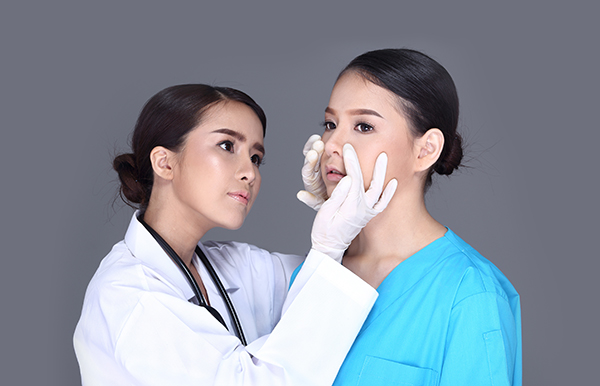More and more OFWs have been undergoing aesthetic plastic surgery for reasons beyond vanity: They want to increase their marketability.
DUBAI: More Filipino workers overseas are now opting to undergo aesthetic plastic surgery to better market themselves for their dream jobs.
This holds true not only for women with disposable income, but also for men who see plastic surgery as a form of investment for a number of reasons. But to put it simply, many OFWs nowadays defy the notion that investing in their personal appearance is a waste of money. Rather, they see is now as a necessity.
Many, on the other hand, are also lured by fake or unlicensed doctors, the Philippine Association of Plastic, Reconstructive and Aesthetic Surgeons (PAPRAS) said.
In an exclusive interview with The Filipino Times, Dr. Laurence Loh, PAPRAS president, said they see the trend of OFWs wanting to improve on their looks because many of them now have the financial capacity.


“Marami sa ating mga OFWs masipag magpadala ng pera sa Pilipinas till they say, ‘Ako naman, enjoy ko naman ang pera ko,” Loh said.
Marketing themselves
The same can be said of overseas Filipino workers (OFWs) in the UAE, especially those in the marketing, hospitality and entertainment sectors, experts in the field told The Filipino Times.
“Yes, it is a little bit of vanity,” said Dr. Laurent Blaga, plastic surgery consultant at Abu Dhabi-based Cosmesurge.
“But there’s always a thing about how much it bothers you. It can be very bothering when people look at you and say, ‘Oh, your lips are like this and that, or your ears are too big.’ You couldn’t focus on your work,” he added.


Blaga said correcting imperfections through aesthetic plastic surgery “is always a balance between vanity and necessity.”
Blaga said he receives Filipina patients “quite often.” He said they come for “small treatments” like lip enhancement and nose correction.
Nose correction
Nose correction it is too for Filipina patients visiting Dr. Biraj Naithani Panchal of NMC Healthcare’s Aesthetic, Reconstructive and Plastic Surgery department.
“I get a lot of Filipino patients. They are interested in nose augmentation. Some of them are interested in breast enhancement,” she said.
Panchal said plastic surgery is not so much about vanity as it is more about meeting the requirements of a person’s job or career.


“The option is there for the person to feel better, wanting to look good. If it can help improve their image, there is no harm in going through it to better market themselves, to be more competitive in their line of work. If it can make a difference for the better, (then why not?)” said Panchal.
Price range
In the Philippines, rhinoplasty starts at Php40,000 (Dh3,000); breast augmentation, at Php100,000 (Dh7,000); and liposuction at Php80,000 (Dh5,600), officials said.
In the UAE, aesthetic plastic surgery is in the range of Dh20,000 to Dh27,000, experts said.
According to Panchal, rhinoplasty costs approximately Dh25,000; breast augmentation, Dh24,000 with implant cost extra; and liposuction of the abdomen, Dh24,000.
Panchal said more often than not, OFWs save their hard-earned money for the procedure because aesthetic plastic surgeries are not covered by insurance.
“There is an option for them to secure a bank loan or use credit cards,” she said.
Dr. Aileen Villanueva, head of department at NMC Mabuhay Clinic, lamented that some OFWs stretch it a bit to spend for plastic surgery and pay little attention to investing in their actual state of health.


“Some are more concerned with their physical appearance rather than their health. They are willing to shell out cash from their pockets for beautification instead of giving at least minimal co-payment for the insurance of their medical health,” Villanueva said.
Numbers on the rise
Meantime, the number of OFWs who are opting for plastic surgery has continued to rise and most of them are blue-collared workers or office workers. Loh said he even had a construction worker in Japan as client, who literally carries hollow blocks for a living and yet wants to undergo the knife to build self-confidence.
Aside from Japan, OFWs from the Middle East, United States, United Kingdom and Italy come to their clinics for aesthetic surgeries.
“Rhinoplasty is often the choice of OFWs coming from countries whose people have high nose bridges. So normally they feel insecure having flat noses,” Loh said.
Aside from rhinoplasty, the second top choice is breast augmentation, especially for entertainers.
The third most popular is liposuction, usually in the tummy area.
There is also a growing number of clients who want to undergo facelifts, especially among elderly women from the US who have chosen to retire in the Philippines. Younger Chinese-Filipinos also come to plastic surgeons for upper eyelids.
False marketing, fake surgeons
However, since OFWs use social media to connect with their loved ones in the Philippines, they are also the subject of false marketing or advertising.
“Many are enticed to undergo plastic surgeries with non-medical practitioners or even with medical practitioners with no license to perform plastic surgery,” Loh said.
While he welcomes the growing interest of overseas Filipinos on plastic surgeries, Loh also lamented the growing number of Filipinos coming to his clinic to repair previously made plastic surgeries done by non-licensed practitioners.
Loh said he has encountered disgruntled plastic surgery clients with infections or distorted noses. “Ang dami!” He said.
Clients who often undergo breast jobs come as pack, and many of them were lured in the social media.
“Many resort to short-cuts, with fillers — mostly illegal or made in China. Injection is attractive to them because it is less surgical and the result is having instant boobs,” he said. It is also less costly, some even offering as low as P10,000.
However, he said, after only few weeks, clients would have infection.
Breast augmentation done by injection is riskier for women in terms of not being able to detect breast cancer earlier.
“If they just inject fillers to the boobs, it would become a problem for breast cancer because most of the time when one does self-exam on breasts or mammography, you would feel multi-cystic lumps. Mammograms won’t be able to detect if the lump is cancerous or not. Kung ma-detect man, advanced stage na ,” Loh said.
He said he has also encountered women who underwent nose jobs and were told to refrain from going out in the sun. It turns out that the rhinoplasty done was through fillers that eventually flat out due to gravity.
Lack of regulation
The proliferation of cases of plastic surgery gone awry can partly be attributed to the lack of regulation in the Philippines.
Loh said the medical profession has long been asking Congress to amend the Medical Act of 1954. “There are also those who lobbied against regulation on specialization,” he added.
So far there are only about 120 Filipinos who specialize in plastic surgery and they are all PAPRAS members.
Medical tourism
Manila, along with Bangkok, has become prime destinations for people wanting to undergo aesthetic plastic surgery. Prices are a lot less expensive than in the US – currency wise. A typical nose job or instance starts at around Php40,000 in Manila; in the US, it averages at $5,350, according to 2018 statistics from the American Society of Plastic Surgeons.
And so, you have travel and tour agency websites advertising plastic surgery packages.
Imoney Learning Center, a financial comparison website, said the Philippines has become “a favorable destination for patients seeking quality medical care and cosmetic surgery at very affordable prices.
“It’s also home to some of the best cosmetic surgeons in the trade, but with a lower overhead cost and professional fee. Many of these cosmetic surgeon even get a celebrity treatment, since they’re getting as much publicity as celebrities on local television.”
(By Malou Talosig and Jojo Dass)




Lou Olvido Parroco, life coach
“No to cosmetic surgery po. Okay na ako sa pag me-make-up to enhance the look but not to significantly alter the natural physical features bestowed on us.”


Vagelyn Tumbaga Federico, HR director
“I am not in favor of plastic surgery. I always go for the natural beauty. Plastic surgery is now becoming more and more common even among the poorer people who would have spent their money on things more important than their appearance. I am not really keen on undergoing cosmetic surgery and I will never ever do that. I am happy being the naturally beautiful me.”


Josie Conlu, Bayanihan Festival chairperson
“Nothing against it. Natural sa tao ang nagpapaganda and it is one way to feel good about yourself. Wala akong gustong ipabago sa ngayon. Not closing doors though. Baka sa future, mag-iba isip ko.”


Camilla Iman, community advocate
I’m not in favor of cosmetic surgery. Why? Because God created me in His own likeness. What I need to do is enhance this beauty the natural way which is what exactly I am doing. I had the chance to avail of a breast augmentation and nose lift for FREE, offered by one of the Philippines’ famous cosmetic surgeons, but I turned it down. I am very much satisfied with what God has given me and I love who I am.
NOTE: I am not against those who undergo or love cosmetic surgery.


Kate Marajas, content producer
“I am in favor of cosmetic surgery. Pero kung bibigyan ng pagkakataon, wala akong ipaparetoke.”


Enelra Villanueva Pingol, media practitioner
“Hindi po ako pabor. Nilikha tayo ng Dios na ganito. Mahalin natin at alagaan natin.”






